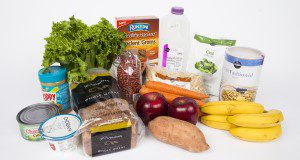Nutrition risk screening is a first step to quickly identify individuals who might be malnourished or at risk of malnutrition. A malnutrition screening tool should be easy to use, quick to administer, and valid—able to correctly identify those at risk of malnutrition. The Comprehensive Older Adult Screening Tool (COAST) is a valid and practical tool to determine if community-dwelling older adults, specifically older adults of lower socioeconomic status, are at risk for malnutrition. This new 6-page publication of the UF/IFAS Food Science and Human Nutrition Department, written by Karima Alabasi, Nancy J. Gal, and Wendy J. Dahl, provides an introduction to COAST as well as the 5-question screening tool.
https://edis.ifas.ufl.edu/fs393
Tag: Nutrition
Meal Planning for Adults with Diabetes
Nutrition, physical activity, and medication are the three main components of a diabetes management plan. According to the Americans Diabetes Association, there is no one diabetes meal plan; rather, it is a healthful eating pattern specifically designed to meet your individual needs. This new 2-page publication of the UF/IFAS Food Science and Human Nutrition Department provides some basic tips for creating a personalized meal plan for adults with diabetes. Written by Nancy J. Gal and Wendy J. Dahl.
https://edis.ifas.ufl.edu/fs323
Diabetes Meal Planning: Managing Your Carbohydrate Intake
If you have diabetes, maintaining a consistent carbohydrate intake throughout the day is an effective meal-planning method to help maintain your target blood glucose levels. Foods that contain carbohydrates have the greatest effect on blood glucose levels compared to foods that contain primarily protein or fat. Carbohydrates in foods that contribute to blood glucose includes sugars and starches. The amount of carbohydrate you consume is based on your diabetes treatment goals and carbohydrate tolerance. This new 3-page publication of the UF/IFAS Food Science and Human Nutrition Department, written by Nancy J. Gal and Wendy J. Dahl, provides a strategy for planning your daily menu to manage your carbohydrate intake.
https://edis.ifas.ufl.edu/fs324
Fibra alimentaria y enfermedades crónicas
La fibra alimentaria tiene muchos efectos positivos en la salud. Esta publicación describe las relaciones entre la fibra alimentaria y la prevención y el tratamiento de enfermedades crónicas.
This new 2-page publication of the UF/IFAS Food Science and Human Nutrition Department is a Spanish translation of FSHN18-11/FS314, Dietary Fiber and Chronic Disease. Written by Wendy Dahl and translated by Daniela Rivero Mendoza.
https://edis.ifas.ufl.edu/fs322
Bebidas nutricionales suplementarias: Las necesito?
Las bebidas nutricionales suplementarias a menudo se usan en hospitales y hogares de adultos para ayudar a nutrir a quienes pueden comer mal y han perdido peso debido a una enfermedad o falta de apetito. Más recientemente, las bebidas nutricionales están disponibles para la compra de los consumidores. Ejemplos de bebidas o batidos nutricionales suplementarios comunes son Ensure® y Boost®. Esta publicación explora la pregunta que muchos adultos mayores se hacen: “¿Necesito bebidas nutricionales suplementarias?”
This new 3-page publication of the UF/IFAS Food Science and Human Nutrition Department is a Spanish translation of FSHN18-12/FS315, Supplemental Nutrition Drinks: Do I Need Them? Written by Claire Marie Fassett, Nancy J. Gal, and Wendy J. Dahl, and translated by Daniela Rivero Mendoza.
https://edis.ifas.ufl.edu/fs321
Sal: ¿Debo recortar su consumo?
La sal alimentaria está compuesta de sodio y cloruro, dos minerales esenciales necesarios para una buena salud. El sodio es muy importante para nuestro cuerpo para mantener el equilibrio de líquidos, el volumen de sangre y la presión arterial. Sin embargo, muchas personas consumen más sodio en la dieta (de la sal) que lo que se necesita. La disminución de sodio en la dieta ha recibido mucha atención en los últimos años debido a la asociación del alto consumo de sodio en la dieta con hipertensión (presión arterial alta) y enfermedad cardiovascular. Esta publicación explora los efectos en la salud de la ingesta excesiva de sodio y las formas de disminuir la ingesta de este mineral.
This new 3-page publication of the UF/IFAS Food Science and Human Nutrition Department is the Spanish version of FSHN 18-9/FS312: Salt: Should I Cut Back? Written by Asmaa Fatani, Nancy J. Gal, and Wendy J. Dahl, and translated by Daniela Rivero Mendoza.
https://edis.ifas.ufl.edu/fs320
Nutrition at Early Stages of Life Determines the Future Growth and Reproductive Performance of Dairy Calves
For a calf, nutrition during the first few months of its life may permanently change the way organs develop and then have long-term consequences. The concept that metabolic imprinting may permanently affect animal development has substantial economic implications for agriculture. This 6-page fact sheet summarizes some of the research conducted in calf nutrition and its impact on the growth and reproductive performance of dairy calves. Written by Philipe Moriel and Luiz Ferraretto, and published by the UF/IFAS Department of Animal Sciences, December 2017.
http://edis.ifas.ufl.edu/an336
Nutrition at Early Stages of Life Determines the Future Growth and Reproductive Performance of Beef Calves
 Nutrition can influence future health and performance of calves. The metabolic imprinting concept has substantial economic implications for animal agriculture, and it should be explored to improve the performance of animals bred for food production. This 6-page fact sheet summarizes some of the research conducted in beef calf nutrition and nutritional impact on growth and reproductive performance of beef calves. Written by Philipe Moriel, and published by the UF/IFAS Department of Animal Sciences, October 2017.
Nutrition can influence future health and performance of calves. The metabolic imprinting concept has substantial economic implications for animal agriculture, and it should be explored to improve the performance of animals bred for food production. This 6-page fact sheet summarizes some of the research conducted in beef calf nutrition and nutritional impact on growth and reproductive performance of beef calves. Written by Philipe Moriel, and published by the UF/IFAS Department of Animal Sciences, October 2017.
http://edis.ifas.ufl.edu/an335
Food Insecurity and Obesity
Food insecurity is prevalent across the US and often coexists with obesity. It is important that the coexistence of food insecurity and obesity is well understood so that community outreach programs and interventions can continue to be implemented in order to improve food security by increasing access to affordable, healthy foods and promoting good health nationwide. This 4-page fact sheet discusses food insecurity, reduced access to healthy food options, the cycle of food excess and deprivation, SNAP, the WIC program, and child nutrition programs. Written by Rachel Savelle and LaToya J. O'Neal, and published by the UF Department of Family, Youth and Community Sciences, February 2017.
http://edis.ifas.ufl.edu/fy1473
Healthy Eating: Drink to Your Health

Shakes and smoothies are a great and delicious way to incorporate more fruits and nutrients into your diet. This 2-page fact sheet is a major revision which provides a variety of refreshing and exciting smoothie and shake recipes as well as preparation tips. Written by Jennifer Hillan, Emily Minton, and Linda B. Bobroff, and published by the UF Department of Family, Youth and Community Sciences. Original publication date: March 2004. Revised March 2012 and September 2015.
http://edis.ifas.ufl.edu/fy696
Frijoles, guisantes, y lentejas: Beneficios de la Salud
 Los frijoles, los guisantes y las lentejas son conocidos colectivamente como legumbres. Los frijoles son una gran fuente de muchos nutrientes, incluyendo proteína, fibra y potasio. This 2-page fact sheet was written by Lakshmi Mahan, Lauren Foster, and Wendy J. Dahl, and published by the UF Department of Food Science and Human Nutrition, January 2014.
Los frijoles, los guisantes y las lentejas son conocidos colectivamente como legumbres. Los frijoles son una gran fuente de muchos nutrientes, incluyendo proteína, fibra y potasio. This 2-page fact sheet was written by Lakshmi Mahan, Lauren Foster, and Wendy J. Dahl, and published by the UF Department of Food Science and Human Nutrition, January 2014.
http://edis.ifas.ufl.edu/fs240
Facts About Energy Drinks (FCS80017/FY1324)
 You can’t walk into a supermarket these days without seeing a wide selection of energy drinks, many claiming that they do everything from boosting your energy to helping you focus. In fact, energy drinks are so popular that, on average, Americans drank about 15 cups per person in 2007. But what’s in a typical energy drink? Do they really work? And are there any health risks from consuming them? This 4-page fact sheet was written by Erica Bub and Karla Shelnutt, and published by the UF Department of Family Youth and Community Sciences, April 2012.
You can’t walk into a supermarket these days without seeing a wide selection of energy drinks, many claiming that they do everything from boosting your energy to helping you focus. In fact, energy drinks are so popular that, on average, Americans drank about 15 cups per person in 2007. But what’s in a typical energy drink? Do they really work? And are there any health risks from consuming them? This 4-page fact sheet was written by Erica Bub and Karla Shelnutt, and published by the UF Department of Family Youth and Community Sciences, April 2012.
http://edis.ifas.ufl.edu/fy1324
Planear las comidas: Use una lista de compras (FCS8933Span/FY1234)
Have you ever gotten home from the grocery store and realized you forgot to buy what you went for? Have you bought foods that you already have at home? Keep this from happening to you again. Write your shopping list before going to the store — it saves time and money. This 2-page Spanish language fact sheet written by Claudia Peñuela, and published by the UF Department of Family Youth and Community Sciences, May 2011.
http://edis.ifas.ufl.edu/fy1234
Nutriente energía y densidad (FSHN1112S/FS177)
Foods for the older adult that has lost weight should target both energy and nutrient density. This 1-page Spanish language fact sheet provides explanation and examples. Written by Wendy J. Dahl and Lauren Foster, and published by the UF Department of Food Science and Human Nutrition, May 2011.
http://edis.ifas.ufl.edu/fs177
Energy and Nutrient Density (FSHN1112/FS176)
Foods for the older adult that has lost weight should target both energy and nutrient density. This 1-page fact sheet provides explanation and examples. Written by Wendy J. Dahl and Lauren Foster, and published by the UF Department of Food Science and Human Nutrition , May 2011.
http://edis.ifas.ufl.edu/fs176







